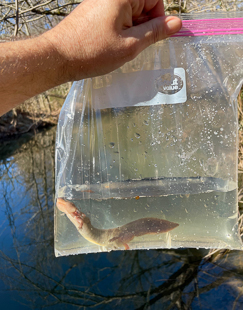Gills on a Puppy Dog’s Face in the Duke Forest
For immediate release ‐ March 29, 2022
Contact: Jon Pishney, 919.707.8083. Images available upon request
 Dwarf Waterdog (Necturus punctatus). Photo: Bryan Stuart/NCMNS. (Click to enlarge.)
Dwarf Waterdog (Necturus punctatus). Photo: Bryan Stuart/NCMNS. (Click to enlarge.)
By Bryan Stuart, Research Curator of Herpetology
Part of Reptile & Amphibian Month. Join us Thursday, March 31 for our final program, “Herp Workshop: Sing Along With Frogs“!
The Dwarf Waterdog (Necturus punctatus) is a fully aquatic salamander that occurs in rivers and streams of the Atlantic Coastal Plain from Virginia to Georgia. In North Carolina, the range of the Dwarf Waterdog extends into the Piedmont as far west as Orange County, where it occurs in New Hope Creek (Cape Fear drainage) of the Duke Forest Teaching and Research Laboratory.
All species of Necturus are paedomorphic, meaning they retain characteristics throughout their lives that are typically found only in the larval stage of salamanders, such as having external gills and lacking eyelids. Being gilled throughout life, these salamanders never leave the water, but instead spend their lives among the sticks, rocks and leaf piles at the river bottom. Their common name stems from having a face that resembles, to some, that of a dog.
The Dwarf Waterdog’s westernmost Piedmont locality at Duke Forest was first documented in October 1954, when the late Duke University professor and herpetologist Joseph R. Bailey captured a specimen that remains preserved today in the North Carolina Museum of Natural Sciences’ herpetology research collections (as specimen NCSM 32456). During 1967–1969, Michael A. Fedak, a graduate student of Bailey’s, studied Dwarf Waterdogs at the New Hope Creek site as part of his thesis work on the genus Necturus in North Carolina, and the specimens that he preserved also remain today in the Museum’s research collections.
To my knowledge, no further sampling for Dwarf Waterdogs has been undertaken at this westernmost Piedmont locality in North Carolina since Fedak’s field sampling ceased in 1969. As Necturus are known to be sensitive to changes in water quality (notably siltation from runoff), and natural landscapes upstream of Duke Forest have been heavily modified from rapid human growth, it was plausible that New Hope Creek’s Dwarf Waterdogs no longer persisted. I decided to check.
With a research permit in hand from Duke Forest, earlier this month I set 12 live traps baited with raw chicken livers and canned cat food into the deep pools of New Hope Creek, where Bailey and Fedak had found them over a half-century ago. The next morning, the first ten traps pulled to shore teemed with small fishes and crayfishes, but no Dwarf Waterdogs. Then Trap #11 yielded its treasure — an adult male Dwarf Waterdog! A second was captured the next night.
DNA sequence data are difficult to obtain from historical, formalin-fixed museum specimens such as the Dwarf Waterdogs that were preserved by Bailey and Fedak in the 1950s and 1960s. High-quality genetic samples taken from the two 2022 individuals are now stored in the Museum’s herpetology research collection’s -80°C ultra-cold freezer, ready for researchers keen to learn more about these amazing amphibians. Fedak’s longer sampling during 1967–1969 showed the species to be relatively abundant at the site, and a next step might be a mark-recapture study to estimate the current population size.
But for now, I am reassured by the continued persistence of the Dwarf Waterdog at its westernmost Piedmont locality in Duke Forest. Hopefully these and other elements of the Triangle’s biodiversity can cling to survival in our rapidly changing environment.
For more information about our upcoming activities, conservation news and ground-breaking research, follow @NaturalSciences on Instagram, Twitter and Facebook. Join the conversation with #visitNCMNS.


